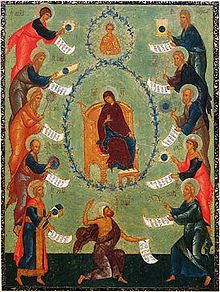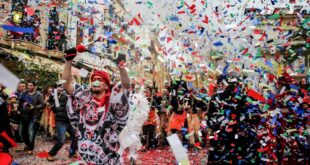Yesterday evening, Friday 16th March, the official start of the lead up to Easter began. The first Hairetismous (Χαιρετισμούς) or Greetings, began and from now on Church Bells will sound every Friday just before dusk to announce each Greeting.
What are Hairetismous?

The Greetings encompass in poetic form, with beautiful words, all of Orthodoxy basic teachings of Christ, the incarnation of the role of the Virgin for the salvation of man, but for the human race to union with God and the help requesting from Jesus and Mary.
The akathist, or Greetings/Salutations, is a large and important poem, written in the 6th century AD, speaking to Mary and tells of her praise, thanks and prayers.

When the word akathist is used alone, it most commonly refers to the original hymn by this name, the 6th century Akathist to the Theotokos, attributed to St. Romanos the Melodist. It is said the Theotokos appeared to him, gave him a scroll and commanded him to eat it. It was here a miracle was performed: Romanus received a beautiful, melodic voice and, simultaneously, the gift of poesy. This hymn is often split into four parts and sung at the “Salutations to the Theotokos” service on the first four Friday evenings in Great Lent; the entire Akathist is then sung on the fifth Friday evening. Traditionally it is included in the Orthros (Matins) of the Fifth Saturday of Great Lent, which for this reason is known as the “Saturday of the Akathist”. In monasteries of Athonite tradition, the whole Akathist is usually inserted nightly at Compline.

The four sections into which the Akathist is divided correspond to the themes of the Annunciation, Nativity, Christ, and the Theotokos herself.
The hymn itself forms an alphabetical acrostic—that is, each oikos 24 in total, begins with a letter of the Greek alphabet, in order—and it consists of twelve long and twelve short oikoi. Each of the long oikoi include a seven-line stanza followed by six couplets employing rhyme, assonance and alliteration, beginning with the greeting Haíre and ending with the refrain, “Rejoice, Bride without bridegroom!” (also translated as “Rejoice, thou Bride unwedded!”) In the short oikoi, the seven-line stanza is followed by the refrain, Alleluia.

There have been very beautiful Greetings written for many other saints, but the Salutations to the Virgin Mary is the basic inspiration for all that others written after.
In fact, they are broken down into four parts, each part being sang on the four separate Fridays and then on the 5th week the entire Hymn is sung altogether.

So, over the next couple of weeks you will hear the Hymn throughout Zakynthos being sung and an extra special delight when you hear the choirs of Faneromeni and St. Dionysios churches singing. A reminder that Easter will soon be here.
 Zakynthos Informer Zakynthos Informer
Zakynthos Informer Zakynthos Informer





